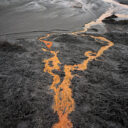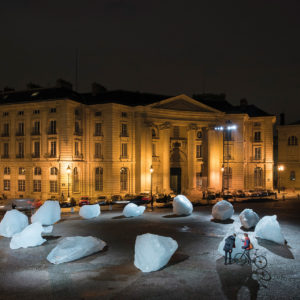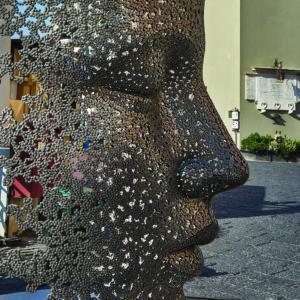Nasce nel 1921 in Germania. Figura profetica ed emblematica, utopista messianico, artista-sciamano, Joseph Beuys è uno dei personaggi più significativi delle correnti concettualistiche della seconda metà del Novecento, precursore di problematiche ambientali, politiche e culturali, nonché fondatore del movimento dei Verdi in Germania, dell’Organizzazione per la Diretta Democrazia e della Free International University.
Durante la seconda guerra mondiale è pilota dell’aviazione tedesca. Prende parte all’offensiva tedesca contro i russi, ma il suo aereo viene abbattuto. Beuys riesce a salvarsi perché trovato, quasi assiderato, da un gruppo di tartari nomadi che lo curano ricoprendolo di grasso e pelli di feltro. Questa esperienza e la crisi di coscienza ad essa legata condizioneranno la sua futura attività artistica.
Le azioni concettuali, le installazioni, le performance sociali, naturalistiche e ambientalistiche, diventano per l’artista tedesco un impegno morale, didattico e politico. Attraverso le sue opere, trascendenti e geniali, e gli oggetti realizzati con l’impiego di materiali come il feltro e il grasso, Beuys vuole generare consapevolezza critica nel pubblico, suscitare in ognuno una propria personale percezione del valore dell’arte, ricongiungendosi al pensiero di Goethe “una volta assicurata l’esistenza, l’uomo è creativo”.
In ogni sua opera è alla ricerca incessante di un’armonia profonda con se stesso, gli uomini e la natura. Per l’artista tedesco, l’uomo è il custode di un’energia in grado di modificare il mondo, dunque ciò che conta è la palingenesi (rinnovamento profondo, trasformazione radicale di strutture politiche o sociali o di costumi), la scoperta individuale di questo potenziale d’energia per trasformare il pianeta. Motore fondamentale di tale processo è la creatività.
Per diffondere la sensibilità ecologica tra la gente, Beuys dà vita a quello che viene considerato il suo capolavoro. Si tratta del progetto “Difesa della Natura” che inizia nel 1982 e si protrae fin dopo la sua morte. Esso consiste nella piantumazione di 7.000 querce nella città di Kassel e di 7.000 piante diverse e rare a Bolognano in Italia. 14.000 sculture vive. Occorreranno 300 anni perché le 7.000 querce diventino il bosco immaginato da Beuys che è riuscito a trasformare un’azione ordinaria come quella di piantare alberi in un grande rito collettivo capace di evocare i significati più profondi del rapporto fra l’uomo e la natura e di ripensare il ruolo sociale dell’artista.
Il credo di Beuys, la sua filosofia e i suoi slogan diffondono amore e fraterna collaborazione fra uomini liberi, valori di cultura, rispetto ambientale, integrazione interculturale e interdisciplinare: “Arte=Vita”, “Ogni uomo è artista”, “La rivoluzione siamo Noi”, “Difesa della Natura”.
Nel 1986 muore a Düsseldorf. Le sue maggiori opere sono conservate nei più importanti musei del mondo.

JOSEPH BEUYS ART SHAMAN
Born in 1921 in Germany. Prophetic and emblematic figure, messianic utopist, artist-shaman, Joseph Beuys is one of the most influential figures in the conceptualistic currents of the second half of the twentieth century, forerunner of environmental, political and social issues, as well as founder of the German Greens movement, the Organization for Direct Democracy and the Free International University.
During World War II he serves as pilot in the German air force. He takes part in the German offensive against Russia, but his plane is shot down. Beuys manages to save himself, as he is found, almost frozen, by a group of tartar nomads who covers him in fat and felt cloths. That experience and the following crisis of conscience would influence is future art production.
The conceptual actions, the installations, the social, naturalistic and environmental performances become, for the German artist, a moral, didactic and political duty. Through his transcendent and brilliant works, and the objects created from materials such as felt and fat, Beuys wants to raise a critical awareness in his public, making everyone create his own personal perception on the value of art, echoing Goethe’s principle “once his own existence is assured, man is creative”.
In each work, Beuys constant searches for a deep harmony between himself, men and nature. For the German artist, man is the keeper of an energy capable of changing the world, therefore, what really matters is the palingenesis (a deep renovation, a radical transformation of social, political structures and habits), the individual discovery of this energetic potential, to transform the planet. The core driving force of this process is creativity.
To spread this environmental sensibility among the public, Beuys creates what is considered his masterpiece. We are talking about his “Defense of Nature” project, started in 1982 and that continued after his death. It consists in the planting of seven thousand oaks in the city of Kassel, and seven thousand different and rare plants in Bolognano, Italy, fourteen thousand living sculptures. It will take three hundred years before these oaks become the forest envisioned by Beuys, who managed to transform an ordinary action, such as planting trees, into a great collective ritual, capable to convey the deeper meaning of the relationship between man and nature, and to rethink the social role of the artist.
Beuys’ creed, his philosophy and his slogans spread love and fraternal collaboration among free men, cultural values, environmental respect, intercultural and interdisciplinary integration: “Art=life”, “Every man is an artist”, “We are the revolution”, “Defense of Nature”.
Beuys dies in Düsseldorf in 1986. His major works are treasured in the world’s most important museums.








No Comments